
|   |

|   |
Traditions and creativity - Shreyaa Suresh e-mail: shreyaa.suresh1712@gmail.com February 4, 2022 The unusual shift of live performances to a virtual setting due to the pandemic has forcefully changed experiences of habituated rituals. One such major shift was the annual Bharatanatyam performances at The Music Academy. Being a January morning tradition for young dancers to watch, meet, and get inspired by fellow contemporaries, this year the routine was switched up a bit, as the distance between the stage and the audience grew much larger. 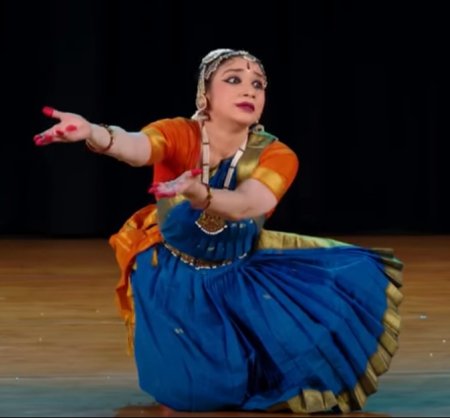 Meera Sreenarayanan I sat in the darkness of my bedroom with only the light of TV with the YouTube link ready, the darkness of the bedroom ever so slightly recreating the darkness of the auditorium before the performance. As I sat alone in the darkness, I noticed there was no shuffling of sarees or sound of jumkis of the fellow dancers who would have sat beside me if it were an auditorium, no legs being moved to give space for people to grab a seat; it was just me and the TV. However, it was not long before I was brought back to feeling comfortable as the curtains opened to the first recital of the festival by Meera Sreenarayanan. Meera had an unusual beginning as she had started with a jathiswaram in ragam Saraswathi. Just for a second, I thought I had missed the first item and tried to rewind and re-watch, a separate privilege that comes with the digital age. There was no disturbance beyond this for my eyes were glued to the TV, mesmerized by the varnam "Innum yen manam" in Charukesi. Meera's choreography under the guidance of her Guru Indira Kadambi was fascinating to witness, how the same varnam can be a voice of both a bhakta as well as a nayika. The kneeling devotee, who has surrendered all to the lotus feet of Lord Krishna contrasted with the haughty nayika who looks her lover in the eye in confrontation, brought out the highs and lows within a whole array of emotions. Towards the end of the varnam, this hierarchy vanished as the Lord recognizes both equally. The varnam provoked me to think more about the difference between bhakti and shringara. Is the imagery of the hierarchy between the bhakta and nayika necessary to show the distinction between the two? Can the depiction transgress this imagery without disturbing the roles of the bhakta and devotee that are important to the narrative of the varnam? Meera's spontaneous head nods to gamakas brought a smile to my face in reminiscence to the synergy of a synchronized appreciation for detailed technicalities, the occasional "besh!" and "sabash!" that I was truly missing from the auditorium experience. I was however grateful that the Music Academy continued to provide the platform for the artist and the rasika without compromising on the safety of everyone, although some small part of me couldn't help but crave the physical interaction between the art and artist. 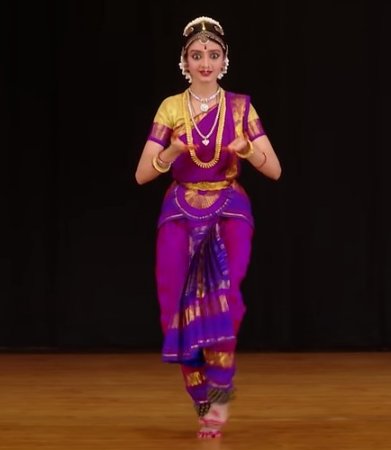 Mahati Kannan Mahati Kannan's performance was my gateway to maintaining my connection to the art despite the odds and appreciating her unique Bharatha Nrithyam style. As I continued to ponder on my previous questions, I realized there is no better inspiration to learn how to break boundaries than Padhu Akka. The research and academic proficiency of Dr. Padma Subrahmanyam lie in her ability to keep historic movement in a continuum. There was a persisting worry at the back of my heart. How can tradition that is demanded by the behemoth stage of Music Academy be maintained if one wants to break barriers? I was pleasantly surprised by the hamsa jathiswaram. It was a fascinating concoction of tradition brought by the karanas from the Natya Shastra in a jathiswaram yet creatively unique in the adaptation of them into swan like adavus. The free flying of the hamsa gave me hope that art is not about just appropriateness but also about expression. Mahati's performance made me appreciate that the beauty of this creative process could be vastly different. Sometimes it lies in the mathematical kannakus in the jathis, but other times it is also in the effortless and utmost graceful movements that take an immense amount of training and control to execute. 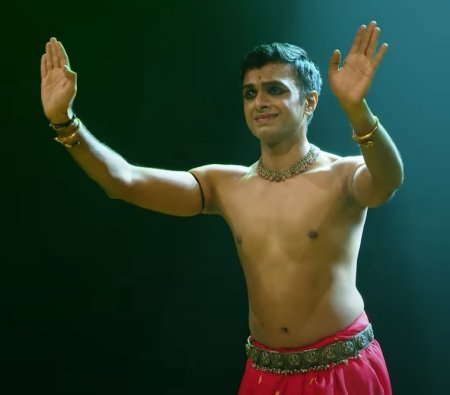 Parshwanath Upadhye Yet another artist I admire for his controlled elegant movements is Parshwanath Upadhye. The transition from Mahati to Parshwanath's performance was as smooth as their movements. Freedom of expression can be easily accessed through story-telling. Adorning the role of different characters, an artist has an opportunity to experience different lives through the same body. Parshwanath's Sutradhara attire while compering is the first compelling shift to identify this format of performance. His story-telling kept me engaged through the performance, as I slipped into magical fantasy through his abhinaya, occasionally disrupted with cutting edge kannaku-heavy jathis and impossible sarrukal adavus. The relatability that Parshwanath has with his memes extends to his abhinaya. A lokadharmi approach without taking away the sanctity of the puranic gods is yet another beauty of keeping authenticity while exploring different ways to relate with an audience through abhinaya. With that, the YouTube premiere of the 15th Annual Dance Festival on the 3rd of January 2022 had come to end. My takeaway from the three performances was to use history, either through compositions, inspired movements, or even puranic stories as a central core that can extend in infinite ways as a way to explore Art. The importance of maintaining "traditions" is not in the comfort of appropriate, repetitive ritual through time, but in indulging in it to continuously re-define it. Leaps of emotions 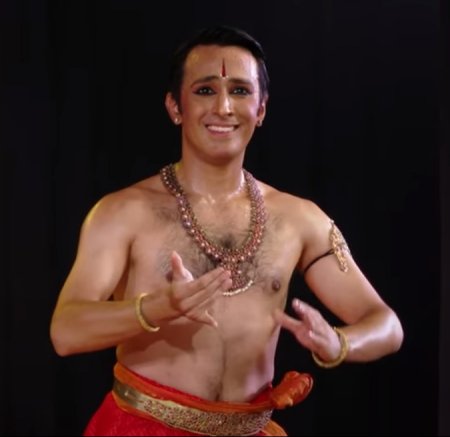 Christopher Gurusamy Taking the first leap into the second day of performances of the Music Academy Dance Festival was Christopher Gurusamy. As I watched his precise Bhramaris and Utplavanams, it almost seemed like a metaphor for the year that was to come. It was a tumultuous start for 2022 Covid wise, with the Omicron taking its peak, and I started the day with confusion as this news kept running in the back of my head. By some miraculous coincidence, there was a connecting link between the three performances of the day that took me on a journey to process all the mixed emotions that I was feeling. Depicted before my eyes were facets of the stories of struggle from the Ramayana, and connecting with these characters through the dance was a much needed form of therapy. Social distancing has made love difficult. The increasing anxiety of being separated from your loved one became a mutual feeling that I shared with Krishna in the Kshetrayya javali "Rama Rama Prana Sakhi" performed by Christopher and choreographed by Bragha Bessell. In this item, Krishna is unable to cope with his sadness of being separated from his lover, reflects his feelings with the struggles that Rama faced. As the choreography extensively recounts Rama's shock at finding Sita missing, Krishna is driven crazy at the thought of putting himself in Rama's shoes. He wonders if he was able to eat and sleep but concludes that he would shrink and crumble in the relentless pain. The paradox of loneliness was an interesting aspect to note. Even though Krishna was feeling lonely, the thought of Rama going through similar feelings, in the greater aspect of things did not make the journey a lone struggle. I sat with the thought that others too might feel the same loneliness in these tough times as the javali let Krishna to his feelings. But the anxiety soon turned into trust issues. In a world of abundant information, who can we trust to provide the truths? In uncertain times like these, what we knew about the virus was becoming redundant. Apoorva Jayaraman came to help me take the next leap into processing my fear of trust. 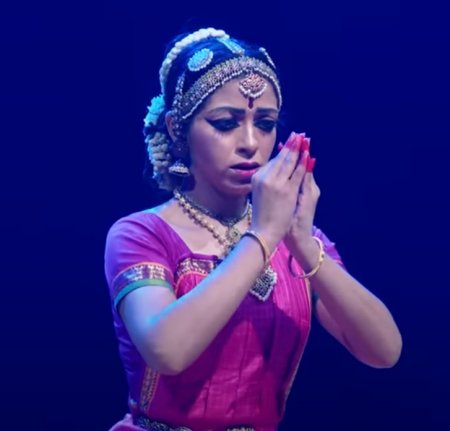 Apoorva Jayaraman Inspired by a short story 'Saapa Vimochanam' by Pudumai Pithan composed into a song by Dr. Rajkumar Bharathi, this piece follows the story of Ahalya. Apoorva portrays the irritation and confusion Ahalya endures for the small mistake that led to a hefty punishment. She is annoyed at her fate, till she sees that Rama is the one to truly understand her and free her. She stays grateful for what Rama does for her, but does Rama always do what is the rightful thing? Hearing of the agni pravesham that Sita was put through, Ahalya feels anger. How can a man that was known to be the beacon of dharma, think the agni pravesham was an action of dharma? Apoorva's portrayal of the disgust and disappointment Ahalya faced, resonated with my anger at the difficulty of defining injustice. As Ahalya took to her stone form in feminist protest, my anger left me helpless. 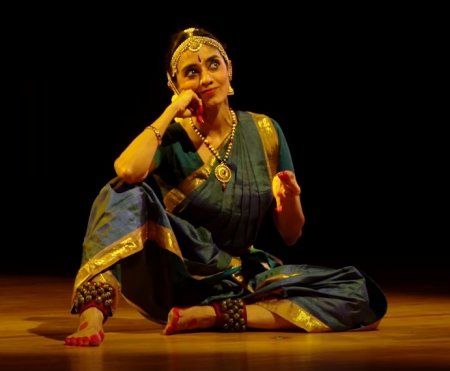 Lakshmi Parthasarathy Athreya When in times of weakness, who better to think of than Hanuman? Providing the last leap on to the land of hope was Lakshmi Parthasarathy Athreya's varnam on the mighty Anjaneya. As she swept across the stage as Hanuman wearing an unusual red kunjalam that reminded me of the tail of the vanara setting fire to Lanka, I could not help but hope there was a metaphorical fire that could kill Corona in a single sweep. Anyone who prays to Hanuman, prays to get the strength and endurance, and Lakshmi's portrayal as Hanuman to put on a charming smile, swish the tail and leap towards uncertainty, to ultimately fly high taught me how to deal with difficult situations. The magical moment with her legs stretched in flying motion under the blue spotlight was an image of a utopian hope that I was craving. I must not forget to mention the odes to Bharathiyar on his 100th death anniversary through the songs "Kanan en thozhan" by Christopher and "Bharatha desam endru peyar solluvom" by Apoorva. The India that Bharathi dreamed of in "Bharatha desam endru peyar solluvom" might not be entirely possible to achieve under these lockdown circumstances. Nevertheless, the experience of witnessing all the six magical performances in two days, appreciating the efforts taken by the artists and organizers to bring this to reality even in this situation gave me the positivity I wish to keep for the rest of the year. 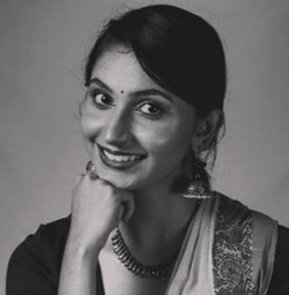 Shreyaa Suresh is a passionate dancer, theatre actor, and an aspiring academic based in Chennai. A post graduate student in anthropology and sociology, she hopes to pursue a doctorate in performing arts and academic writing. |